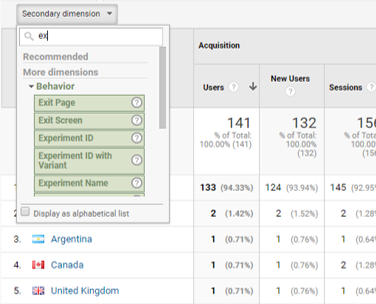Deciphering the Value of Secondary Measurement in Google Analytics: All Concerning Its Importance and Impact
In the world of digital analytics, the application of secondary dimensions within Google Analytics works as a pivotal tool for discerning deeper layers of data understandings. The relevance of second dimensions exists in their ability to provide a nuanced sight of user behavior and interaction with a site or system. By studying information beyond surface-level metrics, organizations can open a wide range of details that improves and forms critical choices marketing initiatives. This expedition right into the world of second measurements not just uses a detailed understanding of customer involvement however additionally clarifies the detailed characteristics that drive online efficiency.
Comprehending Second Measurements in Google Analytics
The understanding of additional dimensions in Google Analytics is vital for acquiring deeper insights right into customer behavior and internet site performance. While key measurements supply fundamental data factors such as website traffic sources and page views, additional measurements allow for an extra nuanced evaluation by giving added context to these primary metrics. By including additional measurements, users can segment and filter their data to discover patterns and fads that might not be instantly apparent.

Introducing the Conveniences of Secondary Measurements
Building upon the fundamental understanding of additional dimensions in Google Analytics, checking out the advantages they supply discloses vital understandings for enhancing information analysis and decision-making. By integrating second measurements, individuals can dive much deeper into their data, acquiring a more thorough sight of customer actions, content performance, and other crucial metrics. One of the main benefits is the capacity to section data, enabling for a more granular analysis of various dimensions such as traffic resources, devices, demographics, and much more. This segmentation enables users to recognize patterns, trends, and relationships that might not be evident when looking at information in accumulation.
In addition, secondary dimensions provide context to primary information, offering additional layers of details that can assist in comprehending user communications and preferences. This enhanced understanding can lead strategic decision-making, resulting in more targeted advertising and marketing projects, internet site optimizations, and overall better efficiency. Basically, secondary measurements act as a powerful device for unlocking deeper understandings and maximizing the utility of Google Analytics for companies and internet site owners.
Leveraging Secondary Dimensions for Boosted Insights
By utilizing the power of second dimensions in Google Analytics, organizations can uncover deeper understandings that drive informed decision-making and critical optimization initiatives. Leveraging secondary dimensions enables companies to delve past surface-level information and acquire an extra extensive understanding of customer behavior, target market demographics, web traffic resources, and web site performance. By incorporating primary measurements like web traffic sources with additional dimensions such as geographical location or gadget group, companies can determine which tools or areas are driving the most valuable traffic to their site.
Additionally, secondary measurements make it possible for organizations to sector and assess data better, aiding them recognize patterns, patterns, and chances that might have browse around here or else gone unnoticed. By making use of second dimensions, businesses can tailor their advertising and marketing approaches, content, and individual experience to much better meet the requirements and choices of their target audience. Basically, leveraging second measurements in Google Analytics encourages services to make data-driven decisions that cause boosted performance, raised ROI, and lasting development.

Influence of Secondary Measurements on Information Evaluation
Enhancing information analysis via the use of second measurements in Google Analytics provides organizations with a deeper understanding of their on the internet efficiency metrics. By including second dimensions, such as time of day, geographical location, or gadget category, services can uncover valuable understandings that may have been overlooked with primary measurements alone. This enhanced degree of granularity permits even more accurate division of data, allowing companies to recognize patterns, patterns, and correlations that can drive strategic decision-making.

Making The Most Of Prospective: Second Dimensions Strategies
One essential approach is to incorporate second measurements with main measurements to obtain a detailed sight of individual communications. Coupling the key dimension of 'source/medium' with second measurements like 'touchdown page' or 'tool classification' can reveal which networks are driving web traffic to details web pages or just how customer actions varies across tools.
Moreover, utilizing secondary dimensions to section information based on customer demographics, habits, or modern technology can aid companies tailor their marketing efforts to this page specific target market sections. This targeted method can cause boosted conversion rates, improved individual experiences, and eventually, enhanced ROI. By maximizing the potential of additional dimensions in Google Analytics, companies can make informed choices, enhance their on the internet visibility, and drive lasting development.
Conclusion
Finally, secondary measurements in Google Analytics play an essential function in providing deeper understandings and boosting information evaluation. By making use of second dimensions successfully, businesses can gain a much more comprehensive understanding of user actions and website performance. Integrating second dimensions into data analysis approaches can bring about even more enlightened decision-making and enhanced general efficiency. It is vital for companies to utilize the power of additional measurements to optimize their prospective and achieve greater success in their online ventures (what is a “secondary dimension” in google analytics?).
While key measurements offer essential information points such as traffic sources and page sights, secondary dimensions allow for an extra nuanced analysis by offering extra context to these key metrics. By combining key dimensions like web traffic sources with additional measurements such as geographic place or gadget group, companies can identify which areas or tools are driving the most useful traffic to their site.
By incorporating secondary measurements, such as time of day, geographic place, or gadget group, services can discover beneficial insights that might have been forgotten with main measurements alone. One key technique is to integrate second measurements with key dimensions to obtain an extensive view of customer communications. Combining the primary dimension of 'source/medium' with additional dimensions like 'touchdown web page' or 'tool classification' can expose which networks are driving web traffic to certain pages or just how individual actions varies across gadgets.
Comments on “Introducing the 'Secondary Dimension' in Google Analytics: What You Required to Know”